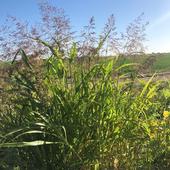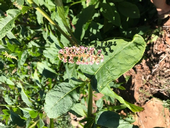- Posted by: Gale Perez

If you missed this year's California Rice VIRTUAL Field Day, you can view it here.
California Rice Virtual Field Day
The full recording can be viewed here.
HIGHLIGHTED weed science presentations:
- 0:20:59 • Florpyrauxifen-benzyl (Loyant): A New Herbicide for California Rice • Kassim Al-Khatib, CE Specialist, Dept. of Plant Sciences, UC Davis
- 0:37:37 • Weedy Rice Trials and Herbicide Failures in the Field •...
- Author: Margaret Gullette Lloyd
- Re-posted by: Gale Perez

From the Small and Organic Farm Advisor Blog
Johnsongrass in organics: Mow it?
Yes, mow it! Mowing works to at least prevent seed spread and regular mowing will weaken rhizomes.
Seed establishment has the greatest potential for the establishment and spread of johnsongrass and must be prevented. Therefore, mowing works to at least prevent seed spread. An individual plant can produce 28,000-30,000 seeds and a single inflorescence can measure 1,240 seeds...
- Author: Richard Smith
- Posted by: Gale Perez

Richard Smith is the Vegetable Crops and Weed Science Farm Advisor in Monterey County, California.
Impatiens Necrotic Spot Virus (INSV) in the Salinas Valley is a tospovirus that is spread primarily by western flower thrips (Frankliniella occidentalis). It has a wide host range of over 600 species of plants, including vegetables such as lettuce, tomatoes and peppers, ornamental such as fuchsias, dahlias and gazanias, and many weeds (see below). In the summer months when INSV is well established, lettuce production fields serve as the primary host of the virus, and thrips fly from infected fields that are being harvested to younger unharvested fields, and in that way, propagate and spread...
- Author: Thomas Getts

The California Weed Science Society met two weeks ago in Monterey. As always, it was an excellent conference with numerous informative sessions across all aspects of weed management in the state.
The first session of the conference “the weed school” focused on hot topics such as drone based mapping, utilizing remote sensing and high-quality imagery to identify plants for robotic and precision-based weeding. It is amazing how advances in technologies are revolutionizing weed control in certain crops! The agenda also devoted time to five presentations focused specifically on glyphosate, which has been a hot topic as of late. Speakers from the state, Cal Poly, UC Riverside, and Bayer presented information related to...
- Author: Travis M Bean
- Re-posted by: Gale Perez

From the TOPICS IN SUBTROPICS blog (Jan. 10, 2020)
Weed Management in Citrus Orchards
Proper weed management is important for several reason, but in general younger orchards are much more susceptible to the negative impacts of weed overgrowth. The full canopies of mature orchards limit the amount of sunlight reaching the orchard floor, which suppresses the growth of many weed species. Younger trees also have less extensive rooting systems, putting them into direct competition with weeds for water and nutrients. The presence of weeds provides habitat for...


